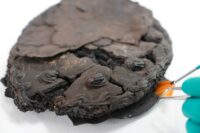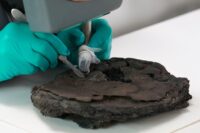 A hazelnut cake complete with swirls of frosting carbonized in the bombing of Lübeck in 1942 has been discovered in a cellar in the city’s historic old town. No food preserved in the firestorm of the bombing has been discovered before in Lübeck. Nor are there any comparable survivors from Hamburg or Dresden, two other German cities that were famously devastated by Allied firebombing.
A hazelnut cake complete with swirls of frosting carbonized in the bombing of Lübeck in 1942 has been discovered in a cellar in the city’s historic old town. No food preserved in the firestorm of the bombing has been discovered before in Lübeck. Nor are there any comparable survivors from Hamburg or Dresden, two other German cities that were famously devastated by Allied firebombing.
City archaeologists unearthed the cake in April during an excavation under a house on the Alfstrasse, a street that leads from the Trave river to Lübeck’s iconic 13th century St. Mary’s Church. Built in 1159, barely 15 years after the city’s founding, Alfstrasse is one of the oldest streets in the Lübeck located in the very heart of the city’s founding district.
 Lübeck was bombed by the Royal Air Force the night of March 28-29th, 1942, and the fires that resulted destroyed large parts of its medieval city center. St. Mary’s was all but levelled (it was reconstructed after the war), as was the merchants’ quarter. The house on Alfstrasse was destroyed in the bombing, but by a miraculous cake-preserving fluke, a cavity formed under the rubble that insulated the dessert from annihilation in the fires or from being crushed in the house’s collapse.
Lübeck was bombed by the Royal Air Force the night of March 28-29th, 1942, and the fires that resulted destroyed large parts of its medieval city center. St. Mary’s was all but levelled (it was reconstructed after the war), as was the merchants’ quarter. The house on Alfstrasse was destroyed in the bombing, but by a miraculous cake-preserving fluke, a cavity formed under the rubble that insulated the dessert from annihilation in the fires or from being crushed in the house’s collapse.
“From the point of view of a restorer, it is the most exciting object that I have ever worked on,” says [conservator Sylvia] Morgenstern. “I first have to wait for the laboratory analyzes. Only then can I decide whether I can clean the find with water and which substance is suitable for stabilization,” she says.
But just like the question of preserving the cake, the archaeologists are concerned with the story behind it. In addition to the charred cake, a coffee service and several records were also found. “Possibly the pastry was intended for a confirmation ceremony. It used to take place on Palm Sunday,” said Schneider. “We hope that we can clarify this with the help of the city archives at some point.” […]
“The cake find is so special because it goes back to an event – namely the bombing raid on Lübeck – that is still present in the minds of the city,” says Doris Mührenberg, who is in charge of the Lübeck Archeology magazine. This is where the “cake mummy” will later find its place – if it is possible to preserve it permanently.